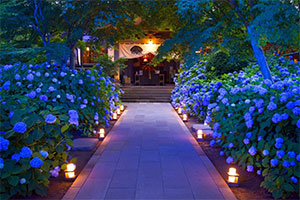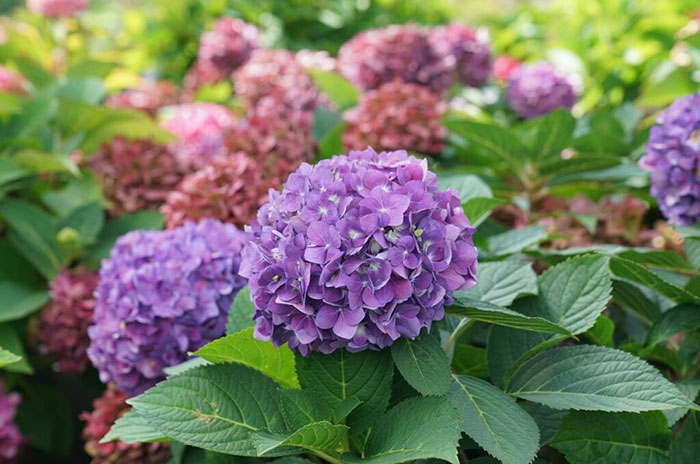Hydrangea Flower Symbolism Facts & Meaning: Zodiac, Superstitions, Dreams, and Legends
I
Hydrangea Flower Facts
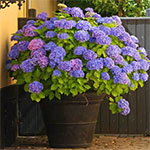
Hydrangea, sometimes known as Hortensia, is a deciduous shrub that blooms from the summer through the fall, showcasing its ethereal hues in gorgeous pompom-like flower heads. Hydrangeas are without a doubt among the world’s most vibrant and exquisite cut flowers. Thankfully, they are also found all over the world, from Southeast Asia to America, a vast home to 70–75 different species of Hydrangea, making it possible for anybody who wishes to enjoy this flower, able to do so.
The Latin words hydros, which means water, and angeion, which means jar, are the source of the etymological meaning of Hydrangea. It came from the conception of Grovonius, the botanist who gave the plant its name, for which the plant made him think of an ancient water pitcher. Something to be fitting given that Hydrangeas require water in order to grow and thrive.
Despite having the appearance of being able to brighten someone’s day simply by glancing at it, Hydrangeas are actually poisonous, which is certainly interesting about the plant. In addition, some species of this flower can change color depending on soil acidity, weather, and the health of the plant. The healthier a Hydrangea, the more vibrant it can be!
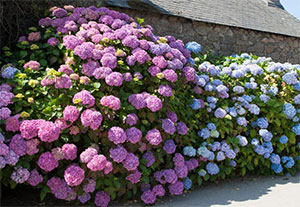
II
Hydrangea Flower Uses
There are many uses for Hydrangea, ranging from decorative blossoms to therapeutic purposes. Because of the range of colors and their spherical flower heads, they make superb ornamental decorations. Hydrangea come in a variety of colors, from pink to exquisite shades of blue and lavender. They can also blossom in hues of white, red, and even green, making them attractive table centerpieces for special occasions especially when placed in a vase. You can also dry Hydrangeas. A dried, pressed Hydrangea in a glass frame is a lovely gift or living room decoration.
The root of the Hydrangea is believed to treat prostate or urinary tract problems in a conventional medical sense. Hydrangea, a flower that continues to bloom in water, is thought to have diuretic properties that enhance urine flow and lessen symptoms of urinary tract infections. In contemporary medicine, Hydrangea is now utilized as a supplement to safeguard body organs, including the liver and kidneys. Some of the beneficial components present in the plant are determined to mitigate liver toxicity, lower blood sugar levels, reduce blood urea nitrogen levels, and act as an anti-inflammatory.
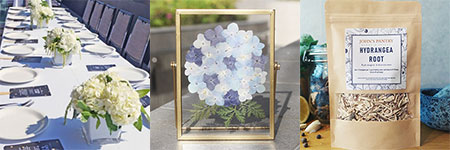
III
Hydrangea Flower History
Although the ancient Hydrangea fossils which ranges 40-65 million years ago were found in North America, Hydrangea have been of foremost cultivated in the soil of the mountainous regions of Japan. After then, it was introduced to Europe in 1736 when a colonist from North America carried it to England. Hydrangeas are now commonly found anywhere.
Hortensia, a term that dates back to 1771 and was originally used by a French botanist by the name of Philibert Commerson, also refers to the Hydrangea plant. According to theories about its origin, the flower was named Hortensia after a woman, who may have been the botanist’s mistress or a well-known astronomer he knows well.
While there are many theories about how it got its name, some thought it might have come from a Latin phrase that meant “from the garden.” Garden is translated to hortus in Latin, which ties up with the story that Philibert Commerson came across Hydrangea in the garden of King Mauritius.
However, because they originated and are primarily found in the mountainous regions of the Japanese islands, Hydrangeas are known as Mountain Hydrangeas in their native habitat. The Japanese word for Hydrangea, ajisai, is another name for the plant that may be frequently mentioned.
IV
Hydrangea Flower Positive Symbolism
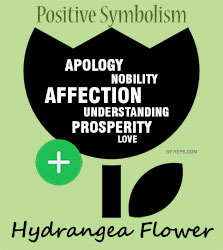
Depending on their color, Hydrangea blossoms are linked to a variety of positive connotations. Giving someone a blue Hydrangea expresses your regret and apology. Pink Hydrangeas represent sincere affection and the essence of love, hence receiving one can put a smile on your face. Additionally, when fully bloomed, it literally looks like a heart!
The lavender ones are symbolic of deep understanding, prosperity, and nobility. On a couple’s fourth wedding anniversary, it is frequently given as a present. Giving your spouse a purple Hydrangea after four years of marriage is a lovely way to express your appreciation.
V
Hydrangea Flower Negative Symbolism
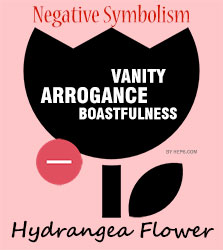
While the white Hydrangea has certain positive connotations, such as purity and grace, it also carries a negative connotation in some cultures, representing male arrogance, vanity, or boastfulness. In the Victorian era, men would literally give a white Hydrangea Flower to a woman who had rejected them as a way to mock them of frigidity.
VI
Hydrangea Flower Cultural Symbolism
The Hydrangea is a flower that is indigenous to South Asia, Japan, and America. Because of this, these locations are where the majority of the symbolism attached to these colorful flowers emerged.
In Japan, Hydrangea is closely linked to sincere feelings, compassion, and regret. This is due to the myth that a Japanese emperor sent blue Hydrangeas to his beloved’s family as atonement for having neglected her. The emperor was not only successful in convincing the girl’s parents, but he also won the hearts of his entire empire. Because of this, the blue Hydrangea is also related to togetherness and unity.
But in Victorian times, bragging and boastfulness were adversely linked with white Hydrangeas. It is thought that giving it as a present is a man’s way of insulting a woman who rejected him by accusing them of frigidity. As a result, women thought that if they were having trouble finding a romantic partner, it was because there was a Hydrangea growing in their backyard.
VII
Hydrangea Flower Zodiac Sign

It has been told that since Hydrangeas require a lot of water to bloom and survive, it was given the name Hydrangeas as a combination of the Greek words hydro and angos, which translate to water vessel. Because Hydrangeas need a lot of water to survive, they are a suitable birth flower for anyone born under the water sign of Cancer.
Cancer is a sign of the emotions, and they can feel as intense as the ocean’s depths. They have a tendency to be very peaceful, yet when they feel overwhelmed, their emotions can be strong like a tidal wave. The same is true of Hydrangeas; you can nourish them with water, but if you do so excessively, you risk slowing its growth and possibly causing them to perish.
VIII
Hydrangea Flower in Dreams
Like its symbolism and meaning in the waking life, dreaming of Hydrangeas can vary as well.
Dreaming about a Hydrangea in bloom denotes harmony and togetherness. It is trying to convey that you have a peaceful, flower-like relationship with the people around you. It might also indicate the beginning of new relationships or suggestive of warm welcomes into a home or new environment.
However, having a dream about withering Hydrangeas implies that you may experience some setbacks in your relationships, whether they are with friends, a romantic partner, or both.
IX
Hydrangea Flower Omens and Superstitions
People believe that Hydrangeas should never be planted near the door because of a Victorian belief that states doing so will prevent your daughter(s) from getting married. In the Japanese culture, Hydrangeas are said to have a strong magical capacity to ward off evil spirits. Hydrangeas are carried or scattered by people around their homes to dispel any evil omens or curses they may have been subjected to.
In witchcraft, if you are cursed by a witch, a Hydrangea is a tool that can be used to break hexes by burning the bark.
X
Hydrangea Flower Mythology and Folklore
Contrary to other myths and tales telling to avoid the plant, the Japanese, Greeks, and Romans planted Hydrangeas in their gardens because they believed the bright, round-headed flowers could ward off evil spirits and keep people safe with good energy.
